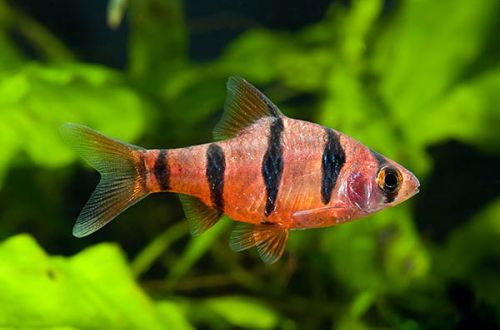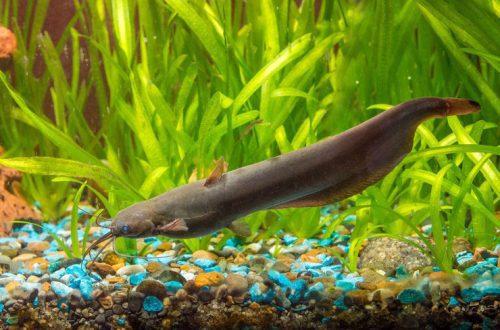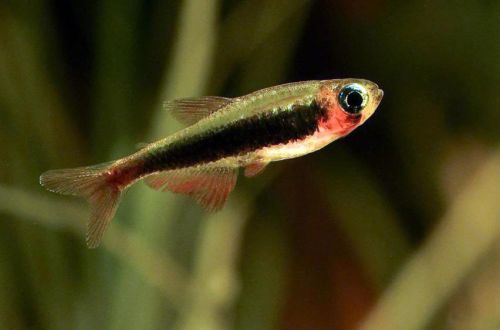
Six-banded Barbus
The six-banded barb, scientific name Desmopuntius hexazona, belongs to the Cyprinidae family. A bright, energetic, peaceful fish that makes a great addition to the freshwater aquarium community.

Contents
Habitat
It comes from Southeast Asia from the territory of the southern part of the island of Borneo, eastern Sumatra, Singapore and the Malay Peninsula. It inhabits dark peat bogs, the water in which has a rich brown or even black color due to the high concentration of tannins formed as a result of the decomposition of plant organic matter. The water is acidic (3.0–4.0 pH) and has very low carbonate hardness.
Brief information:
- The volume of the aquarium – from 80 liters.
- Temperature – 21-26°C
- Value pH — 4.0–7.0
- Water hardness – soft (1-5 dGH)
- Substrate type – any soft
- Lighting – subdued
- Brackish water – no
- Water movement – weak current or still water
- The size of the fish is up to 5 cm.
- Food – any food
- Temperament – peaceful calm fish
- Keeping in a flock of 10 individuals
Description
Outwardly, it is almost completely identical to the closely related species, the Five-Striped Barbus. Based on the name of the species, it can be assumed that the differences lie in the number of dark stripes on the body. In fact, the number of stripes they have is the same – five pronounced and one, the sixth at the base of the tail. The latter sometimes appears, sometimes not. The lack of regularity in the number of stripes is a small incident in the scientific name.
The difference lies in the small black spot on the posterior base of the dorsal fin, which is absent in the Six-striped Barb.
Differences between Five-banded and Six-banded barbs
 A black spot on the posterior base of the dorsal fin is found only in the Five-banded barb, while it is absent in the Six-banded barb. Otherwise, both species are almost identical.
A black spot on the posterior base of the dorsal fin is found only in the Five-banded barb, while it is absent in the Six-banded barb. Otherwise, both species are almost identical.
Adults reach a length of about 5 cm. The color is light with pink, orange or red hues. The pattern consists of 5–6 dark vertical stripes. Sexual dimorphism is weakly expressed. Females, unlike males, look somewhat larger, the color is not so bright.
Food
Omnivorous species. The daily diet may consist of popular dry food. The periodic addition of live or frozen foods such as brine shrimp, bloodworms, daphnia, etc. is welcome.
Maintenance and care, arrangement of the aquarium
The optimal size of an aquarium for a flock of 10 fish starts at 80 liters. Six-banded Barbs, living in the artificial environment for generations, have successfully adapted to conditions that can be very different from a natural reservoir. Thus, the design is not essential. However, it is recommended to provide some cover and the lighting should not be too bright. For example, plants floating on the surface will be an excellent means of shading.
If the design is a matter of personal taste of the aquarist, then the requirements for the composition of the water must be strictly observed. It is impossible to allow the accumulation of organic waste (food residues, excrement) by regularly cleaning the soil and replacing part of the water with fresh water, the hydrochemical composition of the water must be maintained in the ranges of 4.0–7.0 pH and 1–5 dGH. Do not keep fish in hard alkaline water!
Behavior and Compatibility
Peaceful active fish that prefer to be in a large group of 10 individuals. Compatible with many other aquarium fish of comparable size. However, sluggish and very small fish, as well as those with large veil fins, should be excluded from the list of compatible species. Many barbs tend to nibble off their long fins and tails.
Breeding / breeding
Under favorable conditions, the fish successfully breed even in a common aquarium. But in this case, the eggs and fry that appear will most likely be eaten. If breeding is planned, then Six-Striped Barbs should be transplanted into a separate tank. The bottom is covered with a special spawning substrate that will protect the eggs from being eaten. For example, it can be a layer of large pebbles, decorative balls, a fine mesh, thickets of small-leaved stunted plants, etc. After spawning, the fish return to the main aquarium.
Fish diseases
A balanced diet and suitable living conditions are the best guarantee against the occurrence of diseases in freshwater fish, so if the first symptoms of an illness appear (discoloration, behavior), the first thing to do is check the condition and quality of the water, if necessary, return all values to normal, and only then do treatment. Read more about symptoms and treatments in the Aquarium Fish Diseases section.





